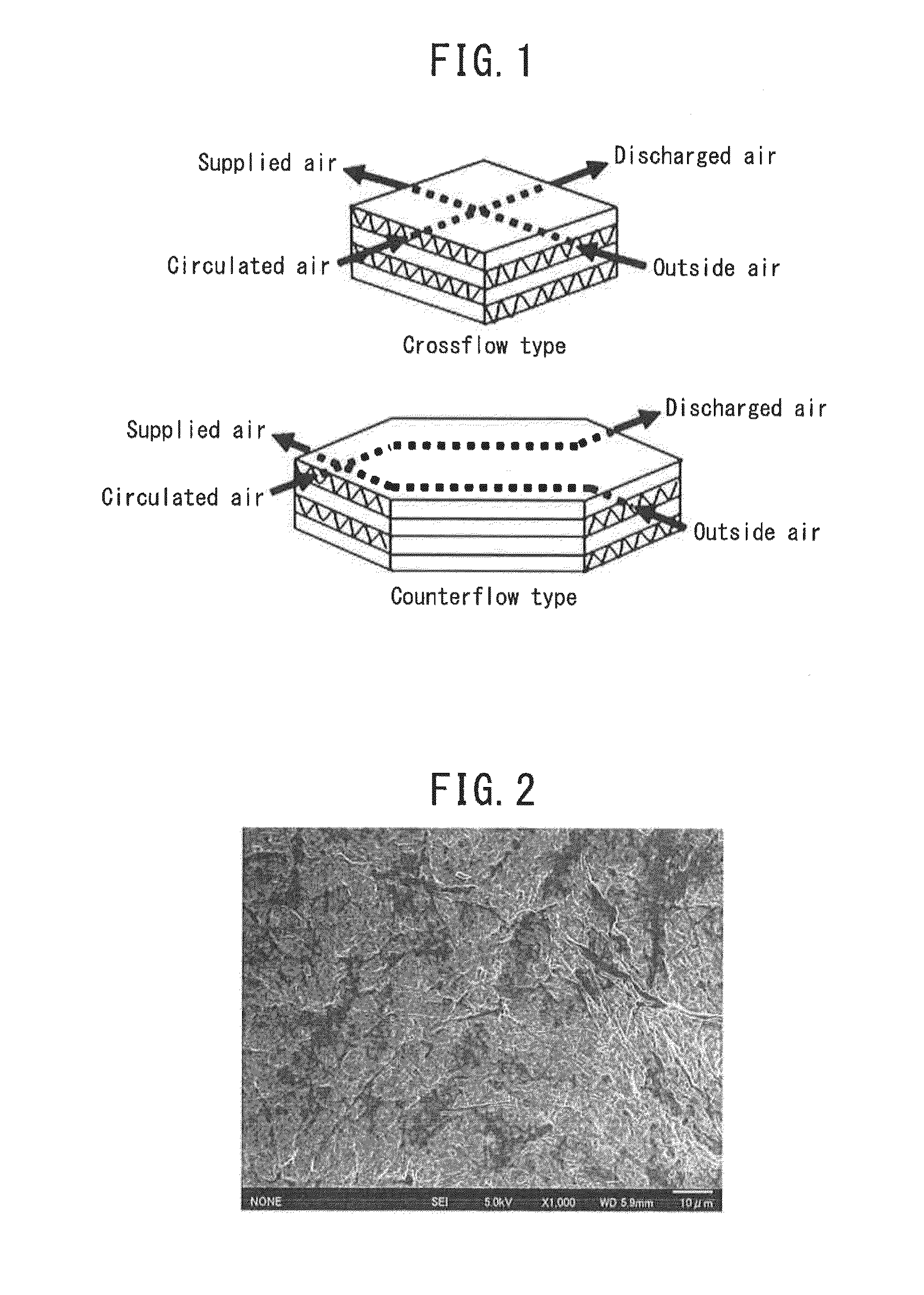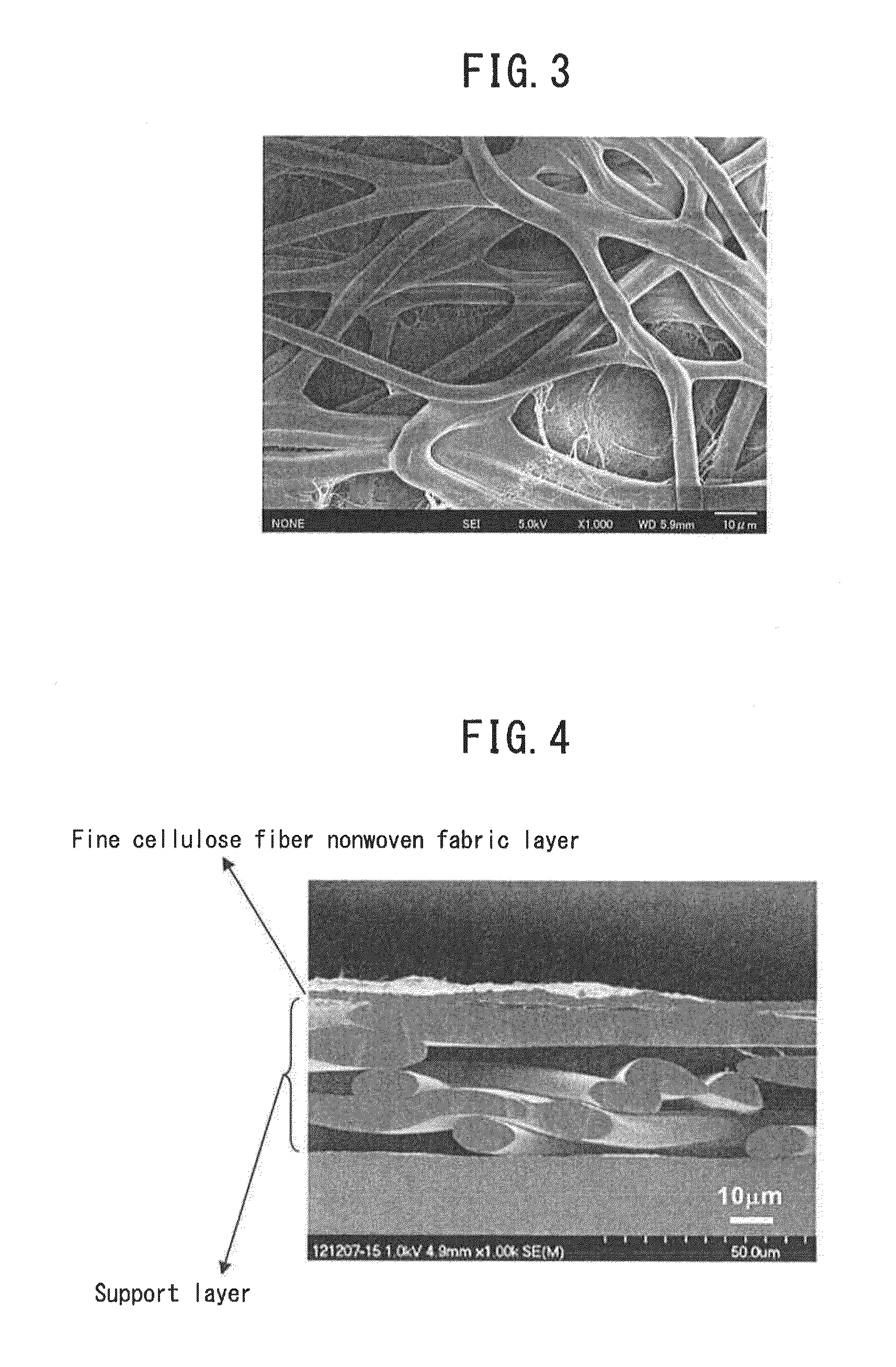Multilayered structure comprising fine fiber cellulose layer
a fiber cellulose and multi-layered technology, applied in the direction of stationary plate conduit assemblies, pulp material addition processes, paper after-treatment, etc., can solve the problems of reducing the loss of air-conditioning energy attributable, becoming a problem, and the “sick house syndrome”, caused by volatile organic compounds, to achieve high moisture permeability, high moisture permeability, and high moisture retention
- Summary
- Abstract
- Description
- Claims
- Application Information
AI Technical Summary
Benefits of technology
Problems solved by technology
Method used
Image
Examples
example 1
[0142]Cotton linter pulp was immersed in water to a concentration of 10% by weight followed by subjecting to heat treatment for 4 hours in an autoclave at 130° C. and repeatedly rinsing the resulting swollen pulp with water to obtain swollen pulp immersed in water.
[0143]The swollen pulp was dispersed in water to a solid content of 1.5% by weight to obtain an aqueous dispersion (400 L) followed by proceeding with beating treatment for 20 minutes on the 400 L of aqueous dispersion using a disk refiner in the form of the Model SDR14 Labo Refiner (pressurized disk type) manufactured by Aikawa Iron Works Co., Ltd. at a disk clearance of 1 mm, and continuing with beating treatment under conditions such that the clearance was subsequently reduced to nearly zero. When samples were taken over time and evaluated according to the Canadian standard freeness (abbreviated CSF) test for pulp as defined in JIS P 8121 to determine CSF values, CSF values were determined to decrease over time, and whe...
examples 2 to 4
[0146]Papermaking and drying were carried out using the aqueous dispersion slurry M1 of fine cellulose fibers prepared in Example 1 and under exactly the same conditions as Example 1 with the exception of forming a fine cellulose fiber layer equivalent to a basis weight of 5 g / m2 on the cupra rayon nonwoven fabric used in Example 1 to obtain an integrated sheet-like structure S2 (basis weight: 20 g / m2) having double layered structures (Example 2). Although S2 had a lower basis weight of the fine cellulose fiber layer in comparison with S1, it had a tensile strength of 1.1 kg / 15 mm, indicating adequate strength for handling. The thickness of the fine cellulose nonwoven fabric layer of S2 as determined from a cross-sectional SEM image was 3.6 μm.
[0147]Next, calendering treatment (using a roll press manufactured by Yuriroll Co., Ltd.) was carried out on S1 and S2 an in attempt to reduce thickness. A metal roll was used for the upper roll, an aramid roll (hardness: 1.29) was used for th...
examples 5 and 6
[0148]Abaca hemp pulp was immersed in water to a concentration of 10% by weight followed by carrying out heat treatment for 4 hours at 130° C. in an autoclave and repeatedly rinsing the resulting swollen pulp with water to obtain swollen pulp impregnated with water.
[0149]The swollen pulp was dispersed in water to a solid content of 1.5% by weight to obtain an aqueous dispersion (400 L) followed by carrying out beating (beating to a CSF value of 588 ml↑) and downsizing treatment in the same manner as Example 1 to obtain an aqueous dispersion M2 of fine cellulose fibers (solid concentration: 1.5% by weight). Subsequently, dilution with water from M2 and dispersion were carried out using the same procedure as Example 1 to prepare a papermaking dispersion (solid content percentage: 1.5% by weight) followed by carrying out papermaking such that the basis weight of the fine cellulose fiber layer on the cupra rayon base material was 5 g / m2, and carrying out pressing and drying in the same ...
PUM
| Property | Measurement | Unit |
|---|---|---|
| density | aaaaa | aaaaa |
| thickness | aaaaa | aaaaa |
| diameter | aaaaa | aaaaa |
Abstract
Description
Claims
Application Information
 Login to View More
Login to View More - R&D
- Intellectual Property
- Life Sciences
- Materials
- Tech Scout
- Unparalleled Data Quality
- Higher Quality Content
- 60% Fewer Hallucinations
Browse by: Latest US Patents, China's latest patents, Technical Efficacy Thesaurus, Application Domain, Technology Topic, Popular Technical Reports.
© 2025 PatSnap. All rights reserved.Legal|Privacy policy|Modern Slavery Act Transparency Statement|Sitemap|About US| Contact US: help@patsnap.com



